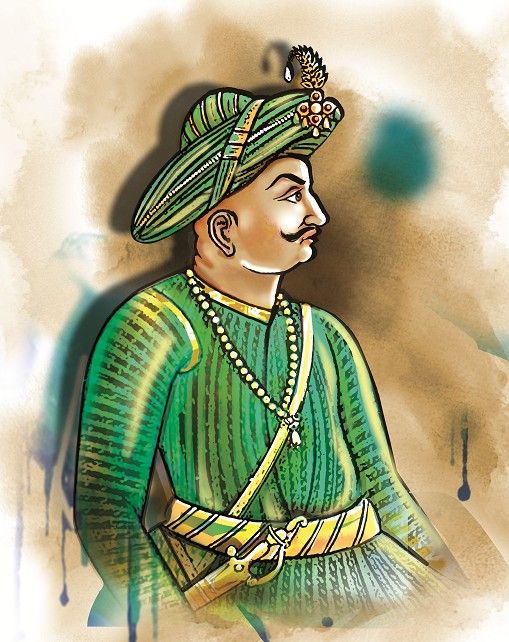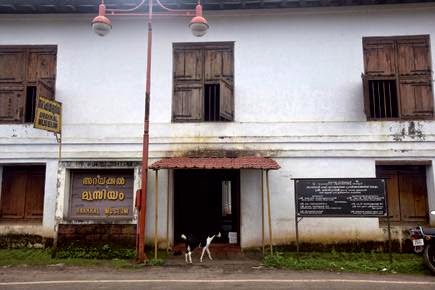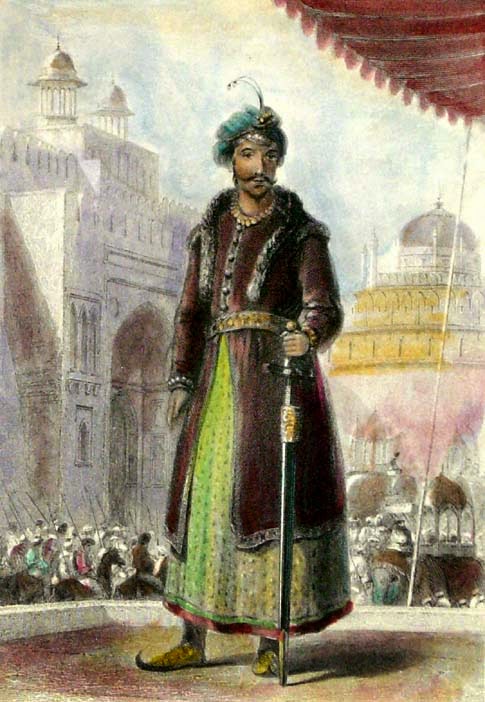
Tipu married two women the same evening, in 1774, when he was 24. He entered into matrimonial alliance with the Arakkal family to consolidate his position in Malabar.
By Ramachandran
In his book, Splendors of Royal Mysore: The Untold Story of the Wodeyars, Vikram Sampath alludes to a mysterious part in the life of Tipu Sultan. I quote:
The confirmed resistance of the Nairs and the tacit understanding and support they received from the British became a nightmare for Tipu. This was the most decisive event during his reign, other than the attacks of the Nizam and Marathas or subjugating the Wodeyar family in Mysore. He entered into matrimonial alliance with the Arakkal family to consolidate his position, in Malabar. His son, Abdul Khaliq was married to Arakkal Bibi’s daughter. He even sent further requests to the British at Tellicherry to refrain from helping the rebels in Malabar.
Sampath has not revealed the source of this information. A Sreedhara Menon, in his History of Kerala, records: Tipu visited Kannur and celebrated the nuptial ceremony of his son, Abdul Khaliq, with the daughter of Arakkal Beevi. After transferring some territory of Kolathiri, to Beevi, he went to Chavakkad by the sea shore, and from there, to Coimbatore.

The period of the marriage was, 1789, according to East India Company records. It was when Tipu descended on Malabar through the Thamarassery ghat. Born in 1782, his son Khaliq was just seven year old then. Three years later, in 1792, he was held a hostage, with his young brother, Muizz-ud-din, by the British, as part of the treaty of Srirangapattana. Khaliq was just 24, when he died on September 12, 1806.
On cross checking, I found the marriage, has been mentioned in the Malabar Manual of William Logan, itself: Tipu visited Kannur and solemnized the preliminary ceremonies of a marriage between Bibi’s daughter and Khaliq.
The decision of the marriage, was politically correct. A relationship with Arakkal, the only Muslim kingdom in Kerala, would have served his interests in the region, very well. Hyder Ali’s wish to marry off Tipu to a daughter of the Nizam was once rejected by the Nizam, on the ground that Hyder was just a Punjabi commoner. Then, Hyder fixed a Navayat girl, Raushan Begum, daughter of Imam Saheb Bakshi of Arcot. Tipu himself chose, Ruqayya Banu, his child hood flame, daughter of General Lala Milan who died in the battle of Melkote. She was also the sister of Commander Burhanuddin. Tipu married both, the same evening, in 1774, when he was 24.
Tipu Sultan (1750-1799), had 16 sons in various women, and the last son died at child birth in 1797, two years before his death. His 11th son, Muhammad Nizam Ud din died the same year he was born, in, 1791.
Then, Arakkal Raja was, Junumabe II. Her predecessor, Kunhi Amsa II had died in 1777. She ruled the kingdom during, 1777-1819. In the Arakkal family, even the female ruler was called Raja. There is historical evidence of Tipu meeting her, which will be discussed later.
When Hyder Ali overthrew Krishna Raja Wodeyar II in 1759, Kunhi Amsa II declared allegiance and Hyder made him the Naval Chief. In 1752, Kunhi Amsa had captured the Sultan Muhammad Imaduddin III (1750-1757) of Maldives, transported him to Kavaratti, part of Lakshadweep under Kunhi Amsa. He died in captivity. After becoming Hyder’s Naval Chief, Kunhi Amsa captured the then Sultan of Maldives, Hasan ‘izz Ud-din (1759-1766) and presented him to Hyder, after gouging out his eyes. Hyder, apologized to the Sultan for gouging out the eyes, gave him back the Sultanate and divested Kunhi Amsa of the Navy Commander ship. The relationship was recouped after the conquest of Bednur, in 1763, to crush the Nair rebellion. Ali Raja Muhammad Ali III had sent Mapila forces to help the Mughal King Aurangazeb, during the Child’s war of 1686-1690.Sir Josiah Child was the Governor in London. Arakkal lineage was much more royal than that of Tipu. It traces its beginning to the Commander of Kolathiri, Arayankulangara Nair, embracing Islam, along with his wife, who was a princess from the Kolathiri family.
It is certain that the child marriage didn’t mature or bear fruits. Before dying in 1806, at the young age of 24, Khaliq saw the empire falling and he went through hell.

Tipu Sultan (1750-1799), had 16 sons in various women, and the last son died at child birth in 1797, two years before his death. His 11th son, Muhammad Nizam Ud din died the same year he was born, in, 1791. History has the other 14:Fateh Hyder Ali(1771-1815), Abdul Khaliq (1782-1806), Muhi Ud din(1783-1811), Muizz-Ud din (1783-1816), Miraj Ud din(1784-), Muin Ud din (1784-), Muhammad Yasin (1784-1849), Muhammad Subhan (1785-1845), Muhammad Shukrullah (1785-1837), Sarwar Ud din(1790-1833), Muhammad Jamal Ud din (1795-1872), Munir Ud din (1795-1837), Sir Gulam Muhammed (1795-1872), Ghulam Ahmed (1796-1824).
The women were from near and far- there were Turks, Georgians, and Persians and there were women from Arcot, Thanjavur, Hyderabad and Delhi, apart from locals. There were two sisters of the Raja of Coorg, a niece of his Dewan Purnaiya and three relatives of the Wodeyars.
He had two sons in 1782, three in 1784, two in 1785 and three in 1795! That he begot three sons in 1795 is interesting since, the treaty of Srirangapattana was in 1792, and after that he was spending most of the time in his harem or zanana. Captain Thomas Marriot who was in charge of the harem, has recorded that there were 333 women of Tipu including servants and 268 women of Hyder and few eunuchs in the harem. The eunuchs were the gate keepers of the women’s apartments. The women were from near and far- there were Turks, Georgians, and Persians and there were women from Arcot, Thanjavur, Hyderabad and Delhi, apart from locals. There were two sisters of the Raja of Coorg, a niece of his Dewan Purnaiya and three relatives of the Wodeyars. George V Valentia, who visited the harem after the death of Tipu, has written in his Voyage and Travels, that each lady furnished her apartment according to the fashion of her country. Apart from Tipu, his confidential friend, Rajah Khan had free access to the women. If in Constantinople, the woman of the day was selected at the fall of a kerchief, here Tipu conveyed his intention to the Chief Minister, who in turn, known it to the woman. A diary was found after Tipu’s death which contained, in his own hand writing, names of the girls in the principal families with their age annexed.
The harem was also a safe place for a woman, according to the book, Tarikh-i-Tipu,of Kirmani. The wife of Abdul Karim, Tipu’s brother, was found in Hyder’s harem. She was the daughter of the Nawab of Savanoor, ill-treated by Karim.She was placed in the harem by Tipu.I don’t know whether the claim of the author is right or wrong. Karim’s son, Fatheh Hyder Ali, has also been referred to as Tipu’s elder son in records. I have read the last Raja of Coorg, Chikkaveera Rajendra had made his father’s women in the harem, his own concubines. Kirmani says, Tipu had sent back captured wives of Maratha sardars with gifts. But from Coorg and the Palegar family of Chitradurga, Tipu had forcibly taken princesses.
Tipu, as I said before, married for the first time in 1774 when he was 24 and last probably in 1796 when he was 46. Among the first two wives, the one found by Haider was wife in name only. She, Raushan, was called Padshah Begum.Taking her as Tipu’s wife was resisted by the womenfolk in the palace, because, there were ‘unpleasant rumors’ about her family. His favorite, Ruqayya died in 1799, during the siege of Srirangapattana, out of shock. He married his last wife, Khadija Zaman Begum, daughter of Sayid Saheb, who was in the service of Tipu, in 1795.She died next year in child birth. There is a document called, Authentic Memoirs of Tipu Sultan, written by a British Army officer, which says, Tipu’s wife was about 20, delicate and captivating. This has to be Khadija. So, Tipu had three official wives. The British took Tipu’s sons, Abdul Khaliq and Muizz Ud din, in 1792, as hostages, at the end of the third Mysore war. Khaliq, the second son was, born in 1782, and Muizz, the fourth son, a year later, in 1783. Eyewitness accounts of the Siege say that Khaliq was 8 and Muizz. It is wrong. Khaliq, was 10 and Muizz, 9. Khaliq was the favorite of the Governor General Charles Cornwallis and Lady Oakley, wife of the Governor of Madras, Charles Oakley. Maybe the frailty gave the child less age. It will not be wrong to assume Khaliq and Muizz were born to Ruqayya Banu, because, Khaliq and Muizz were in the palace, and Ruqayya finally died in the palace. The women who didn’t beget sons, were, discarded at the harem. The Kannur marriage gets some authenticity now, as Khaliq, in all probability, is the son of Ruqayya, though there is a theory that Khaliq was the son of a Hindu wife of Tipu.The eyewitness account of 1799 says the mother of the boys died of fright after the attack. It was Ruqayya.
The article 2 of the treaty of Srirangapattana, 1792 said: That the two sons of Tipu shall be detained as hostages till the stipulated sum to be paid at 3 installments, not exceeding 4 months each, shall be discharged-on payment thereof and the cession of one half the country and release of the prisoners-the said 2 sons shall be immediately dismissed.
It took not 4 months, but 18 months, for the release and return of the sons, Khaliq and Muizz Ud din. But all the sons along with family and relatives, about 300, were captured and confined after the Fourth Mysore war and the assassination of Tipu in 1799.So Khaliq became a hostage a second time, at age 17.He lived for 7 more years.
The world got the eye witness account of the 1792 hostage scene from A Narrative of the Campaign in India Which Terminated the War with Tipoo Sultan, in 1792, by Major Alexander Dirom. He describes: The eldest boy, rather dark in color, with thick lips, a small flattish nose, and a long thoughtful countenance was less admired that the youngest, who is remarkably fair, with regular features, a small round face, large full eyes, and a more animated appearance”. The only artist present at the scene was, Robert Home, who was the official war artist of the third Mysore war.
Khalik and Muizz, were delivered to Lord Cornwallis the Governor General, on February 26, 1792, by the Vakil of Tipu, Ghulam Ali Khan. “These children were this morning the sons of Sultan my master, their situation is now changed, and they must look up to your Lordship as their Father”, Ghulam Ali said, as he led them to Cornwallis. Ghulam Ali (1758-1863) Senior Mysore Military Commander, had traveled to Constantinople to meet Sultan Abdul Hamid I during 1786-1790, from Malabar (Tadri port in records) and returned via Alexandria, Jeddah to Kozhikode. He accompanied the sons to Madras. The Madras Council voted 1663 pagodas for the accommodation of the sons in the Fort St George of Madras. Cornwallis was appointed Governor of the Fort William, Bengal, in February, 1786. In the painting by Home, he has included himself in the scene, standing in the left foreground, holding a portfolio. Home was the son of a Scot from Berwick. When the hostage sons left in the afternoon, Tipu was on the rampart, above the gateway. They were received with 21 gun salute near the tent, and met by, Sir John Kennaway and the Maratha and Nizam Vakils, or Commanders. They were led to the Head Quarters, each mounted on caparisoned elephants, seated in silver gowder. The procession was led by Camel harcarras and seven standard bearers carrying small green flags suspended from rockets, followed by 100 pikanen, with spears inlaid with silver, a guard of 200 Sepoys, and a part of horse. At HQ, they were received by a Battalion of Bengal Sepoys, commanded by Captain Thomas Welsh. Enroute to Madras, they visited Hyder’s tomb at Kolar, and arrived at Madras on 29 June 1792.Before occupying a house at Fort St George, they stayed in tents. Col John Doyeton was their guardian.
Elaborate exchanges of gifts happened from next day. Cornwallis gave each a gold watch, following day, Khaliq and Muizz gave him, a Persian sword, jewels and shawls. Corwallis gave a Gun and a pair of pistols. Two palanquins, never unpacked, were found in the palace in 1799.
In 1794 February, after fulfillment of the treaty, when Khaliq and Muizz prepared to return to Srirangapattana, Cornwallis and Lady Oakley presented to Khaliq, the ‘most beautiful palanquin in India, ornamented with solid silver and gold moldings, each side supported by decorative snakes. Muizz used to recite Quranic and Persian verses to Cornwallis. Both were introduced to the Madras social scene with dance, music and dinners.
Now, coming back to the historical background of the marriage, Arakkal Junumabe II had sought protection from the East India Company in 1789, and stated positively that Tipu will be coming shortly to the coast with the whole force. She, it seems, was playing a deep game. Tipu’s visit primarily, was to appease the warring Kannur chieftains. Though the Mappilas of the coast were with the Beevi, the Mappila s of the South resisted Tipu’s authority, and posed a threat to the Beevi. After Hyder’s death in 1782, Beevi had signed an agreement with the Company, a year before the Mangaluru treaty of the Company, with Tipu. By 1789, she had been reinstated in her territory. Tipu’s entry to Malabar in 1789, was his second, as all Rajas and Chieftains of North Malabar revolted and declared independence from Mysore. He devastated Kadathanad just before the marriage ceremony. One of the princes of Kolathiri, was killed by Tipu’s soldiers during his escape and his dead body was dragged by elephants through Tipu’s camp and subsequently hung upon a tree, along with 17 of his followers. Tipu, after the ceremony, handed over a portion of Chirakkal to the Beevi, and by the projected marriage, the trouble from the rebellious Mappila s in the South rapidly disappeared, and they stood on the side of Tipu’s troops, later. He left Malabar, never to return.
A year before, in 1788,Tipu had sent Mohammed Dervich Khan, Akbar Ali Khan and Mohmmed Osman Khan as Ambassadors to King Louis XVI of France. They informed the French government Tipu desired one of his sons received education in Paris. The French approved of the idea, if, before leaving for Paris, or in the course of his journey, the prince could learn to read and write, French, learn a little Calculus and Arithmetic. Louis XVI, who had commissioned a substantial diplomatic gift of Sevres porcelain for Tipu, persuaded one of the Ambassadors to sit for his portrait to Mme Yigee Le Brun. It seems, Tipu had decided to send Khaliq to Paris.
A descendant of Tipu, Noor Inayat Khan, became an Allied spy during Second World war. Her father Hazrat Inayat Khan, was a descendant of the uncle of Tipu Sultan.
When the British learned of Tipu’s order in 1799, to the Dutch agents in Paris, to procure arms and ammunition, the British started the Fourth Mysore war, killing Tipu. This time, it was Major General David Baird, who received the surrender of Tipu’s sons. After the death of Tipu, Baird asked Major Alexander Allan to enter the Fort carrying the flag of truce. He recognized one of the hostage sons. The General was severely affected by the sight of the princes. He received them with regard, assuring no violence. He gave them in charge to Lt Col Patrick Agnew and Captain Marriot. They conducted the princes to the Head Quarters camp, escorted by the 8th Company of the 33rd Regiment. As they passed, the troops were ordered to pay compliment of presented arms. On June 19, they were transferred to Vellore Fort and eventually on 20 August, 1806, to Kolkata, after the Mutiny in the Vellore Fort in the early hours of 10 July, the day of Tipu’s daughter’s wedding. It was the first war of Independence, 51 years before, 1857. If in 1857, Bahadur Shah Zafar was declared King, the Vellore mutineers declared Shehzada Fatheh Hyder Ali, elder son of Tipu, as King (he is also referred as Tipu’s brother Abdul Karim’s son).He had escaped the captivity at Vellore Fort and joined the Maratha Forces, in 1801.The British feared the presence of Tipu’s descendants in South India. A descendant of Tipu, Noor Inayat Khan, became an Allied spy during Second World war. Her father Hazrat Inayat Khan, was a descendant of the uncle of Tipu Sultan. The 14th and last surviving son of Tipu, Sir Gulam Muhammad Khan, was recognized by the British as the official Head of the family, and was knighted in 1870.He died of dengue fever in 1872. His family branch and estate still survives.
The Arakkal kingdom came to an end in 1790, the year in which St Angelo Fort in Kannur was stormed by General Robert Abercromby. The Dutch had sold the Fort to Arakkal for One lakh, in 1772, along with the palace.
______________________
Courtesy: Hamlet in Monsoon Blogs (Posted on Dec 4, 2014)